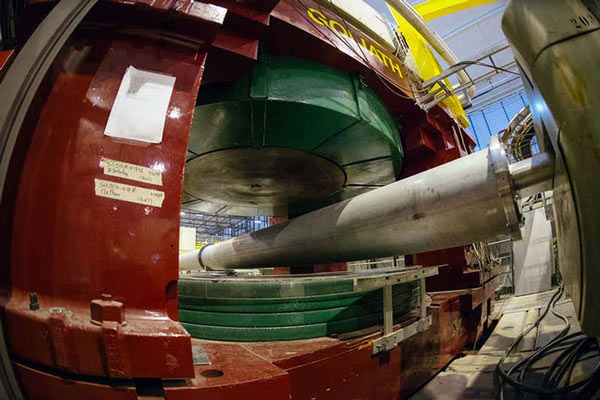There is evidence that confirms the existence of a fifth force, which can reverse the physics we still know
According to Physics, all activities from the smallest (particle size) to the greatest (universe size) are in the universe are governed by 4 things.
- Strong force: This force holds together particles to form atoms.
- Weak force: This force causes the particle's decay process.
- Electromagnetic force: An force that only interacts with charged particles.
- Gravity is the force that causes objects with mass or energy to do.
 There is evidence that confirms the existence of a fifth force, which can reverse the physics we still know Picture 1
There is evidence that confirms the existence of a fifth force, which can reverse the physics we still know Picture 1
However, researcher Attila Krasznahorkay and colleagues at the Atomki Nuclear Research Institute in Hungary believe they have found evidence that a fifth force exists in nature. The researchers discovered this evidence in 2015, after observing the light emitted from the decay activity of beryllium-8.
Beryllium-8 is an unstable structural isotope discovered in the 1930s when the first particle accelerator was built in Cambridge. The existence and mode of beryllium-8 decay has fascinated particle physicists.
 There is evidence that confirms the existence of a fifth force, which can reverse the physics we still know Picture 2
There is evidence that confirms the existence of a fifth force, which can reverse the physics we still know Picture 2
In 2015, when the proton was shot at the lithium-7 isotope (to create beryllium-8), the Hungarian team discovered that the particle decay result was not the same as the original prediction. They also discovered the appearance of a small 'kick', that is, electrons and positrons - when emitting air during the isotopic decay, in a mysterious way, it shot out of each other to form. an angle of exactly 140 degrees.
Researchers have done many similar tests and all have shown similar results.
 There is evidence that confirms the existence of a fifth force, which can reverse the physics we still know Picture 3
There is evidence that confirms the existence of a fifth force, which can reverse the physics we still know Picture 3 Based on that, the team speculated that, at the time of the atom's decay, a new particle was created thanks to the excess energy contained in the atomic components but immediately decayed into a pair. positrons and electrons.
The mysterious particle has an estimated mass of 17 megaelectronvolt so it is called X17 by scientists. This particle carries an interactive force at a distance equivalent to the nuclear width of an atom.
Krasznahorkay said that when they performed the new research with stable helium atoms, they also had the same measurements, the difference here is that the positron and electron pairs burst from the helium atom forming an angle of nearly 115 degrees .
Researchers are continuing to conduct other studies related to X17 particles. If the existence of X17 is confirmed, a fifth force will appear and physics will have to rotate the four known fundamental forces.
- Successfully tested the Mach 5 engine, flying from Hanoi to Ho Chi Minh City. Ho Chi Minh only takes 11 minutes
- Scientists have successfully created a "reverse solar cell" that generates electricity in the dark
You should read it
- Experimental science proves that gravity is still effective at 50 micrometers
- Learn about Brute Force attack
- The 10 most sophisticated and mysterious special forces in the world
- How to customize force sensor gestures on AirPods Pro
- How to Force Shut Down a Mac
- How to Use Force Touch on a Mac
- Black force - a new force in the universe, becomes even more strange
- Tips for fighting in the 1945 Air Force
- Apple denies that iPhone can be brute force to open passwords easily
- US Air Force has a headache for PS3
- What is Ransomware Task Force (RTF)?
- For iron will, apply the 40% rule of SEAL task force
May be interested

Super rare scene: Blue whales ... 'walk heavy' in the middle of the ocean

Every beer bottle cap has 21 aliases, why?

Rossmax nasopharyngeal machine good? How to use it safely?

Why do traffic lights have 3 colors of red - yellow - blue and toilet paper must be white?

Buy sunscreen gloves go cheap, where to play golf cheap?

Why is water wet, fire hot?






 Scientists have found evidence to prove the existence of the parallel universe
Scientists have found evidence to prove the existence of the parallel universe Decode 6 magic tricks that challenge all the laws of physics in the world
Decode 6 magic tricks that challenge all the laws of physics in the world Science has found evidence of the immortality of pseudo-particles: they replicate themselves after decay
Science has found evidence of the immortality of pseudo-particles: they replicate themselves after decay Experimental science proves that gravity is still effective at 50 micrometers
Experimental science proves that gravity is still effective at 50 micrometers Instructions for creating reverse text
Instructions for creating reverse text Download the reverse video creation application, Reverse Movie FX is free on the AppStore
Download the reverse video creation application, Reverse Movie FX is free on the AppStore